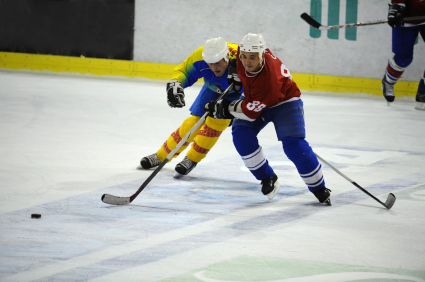Risks And Types Of Injury
 Each year, almost 87,000
hockey-related injuries to youths under age 15 are treated in
hospitals, doctors' offices, clinics, ambulatory surgery centers and
hospital emergency rooms. The total cost of these hockey-related
injuries was more than $978 million in 2006. This amount includes
medical, legal and liability, work loss, and pain and suffering costs.
Each year, almost 87,000
hockey-related injuries to youths under age 15 are treated in
hospitals, doctors' offices, clinics, ambulatory surgery centers and
hospital emergency rooms. The total cost of these hockey-related
injuries was more than $978 million in 2006. This amount includes
medical, legal and liability, work loss, and pain and suffering costs. - Ice hockey involves a significant risk of injury for players of all ages.
- Ice hockey is the second leading cause of winter sports injury among children.
- The most common types of injuries are bruises to the thigh, knee, and ankle. Lower extremity injuries account for about one-third of the injuries.
- There is a high rate of facial lacerations and head injuries (including concussions).
- Cases of paralysis and death resulting from head (Second Impact Syndrome), neck, heart, (Sudden Cardiac Arrest and commotio cordis) and spinal cord injuries have been reported, but such catastrophic injuries are rare.
- Body
checking is the most common cause of injuries, accounting for between 45% and 86% of injuries among youth ice hockey players,1 and is also associated
with the most severe injuries. Many of the players injured by body
checking are hurt as a result of collisions with goal posts or the
boards.
- Contact between opponents, usually in the form of body checking, is associated with 46 percent of all minor injuries and 75 percent of major injuries.
- Concussions are the most common type of specific injury, accounting for more than 15% of all injuries among 9- to 16-year-old players.
- In a Canadian study published in the June 9, 2010 edition of the Journal of the American Medical Association,1 11- and 12-year-old who played on Pee-Wee teams where body checking was allowed were three times more likely to suffer a concussion or other severe injuries than those who played in non-checking leagues.
- Safety gear and changes in the rules of play have significantly reduced both the number and severity of injuries:Many head injuries have been prevented by the use of helmets and the elimination of body checking.
- A reduction in eye injuries has occurred through the addition of full-face guards on helmets and the stricter enforcement of penalties for high sticking.
- Neck guards have reduced the number of both soft tissue and spinal injuries.
Most youth leagues and some high school leagues currently require these safety measures. Other leagues recommend these measures, but are lax on enforcement. A much greater reduction in injuries could be achieved if all amateur - and professional - leagues mandated these safety practices.
Tips for Preventing Ice Hockey Injuries
While injuries are common and can
be severe, many can be prevented if players wear all recommended safety
equipment and avoid moves like body checking that increase the risk of
injury. To help your child avoid injury while playing ice hockey,
follow these safety tips from the American Academy of Pediatrics, the
American Academy of Orthopedic Surgeons, USA Hockey, and other sports
and health organizations:
- Take your child for a pre-participation physical evaluation. Before your child starts a training program or plays competitive ice hockey, he should get a complete physical exam. Your pediatrician can help assess any special injury risks your child may have.
- Make sure
your child wears all the required safety gear every time he or she
plays and practices. All youth, high school, and college ice hockey
leagues require players to wear the following gear:
- Helmet with foam lining, full-face mask, with chin strap properly fastened
- Mouth guard
- Shoulder, knee, elbow, shin, hip, and tendon pads
- Padded hockey pants
- Athletic supporter
- Gloves
- Safety glasses or contact lenses
- Some leagues recommend neck guards. All equipment should be certified by the HECC (Hockey Equipment Certification Council), the CSA (Canadian Standards Association), or the ASTM (American Society for Testing and Materials).
- Make sure your child's equipment fits properly. The helmet should fit snugly with a strap that gently cradles the chin when it's fastened.
- Insist that your child warm up and stretch before playing. Exercises that strengthen the neck and increase flexibility may help prevent injuries.
- Teach your child not to play through pain. If your child gets injured, see your doctor. Follow all the doctor's orders for recovery, and get the doctor's OK before your child returns to play.
- Make sure your child's league has established an emergency medical plan, and insist that an Automated External Defibrillators (AED), and someone trained to use it, are present at the rink at all times.
- Make sure your child's coaches:
- Enforce all the rules of the game
- Encourage safe play
- Understand the special injury risks that young players face
- Limit body checking (some youth leagues prohibit it), or, if checking is allowed, teach the proper "ready" position to anticipate body checks. Checking from behind should never be allowed. This move, which is an illegal play, has been associated with a high rate of injury.
- Teach your child to avoid head contact with the boards or other players. Serious head and neck injuries can occur from this kind of contact.
- Above all, keep ice hockey fun. Putting too much focus on winning can make your child push too hard and risk injury.
1. Emery, Carolyn A. "Risk of Injury Associated with Body Checking Among Youth Ice Hockey Players" J. Am. Med. Assn303, no. 22: 2265-2272 (June 9, 2010).
Updated June 9, 2015








